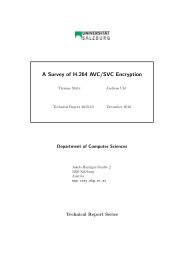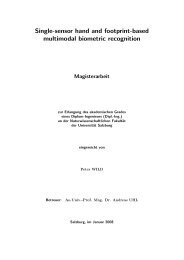Pit Pattern Classification in Colonoscopy using Wavelets - WaveLab
Pit Pattern Classification in Colonoscopy using Wavelets - WaveLab
Pit Pattern Classification in Colonoscopy using Wavelets - WaveLab
Create successful ePaper yourself
Turn your PDF publications into a flip-book with our unique Google optimized e-Paper software.
6 Conclusion<br />
correctly. But also <strong>in</strong> the six classes case we obta<strong>in</strong>ed very promis<strong>in</strong>g results for the Outex<br />
images.<br />
The results we ga<strong>in</strong>ed from our experiments showed that for nearly all methods the SVM<br />
classifier outperformed the k-NN classifier, although the differences are not that huge. Regard<strong>in</strong>g<br />
our results and the much higher computational complexity of the SVM classifier<br />
for most of our methods implemented the k-NN would be the better choice. When look<strong>in</strong>g<br />
at our results for the Outex images, the differences between the two classifiers get even<br />
smaller and for one method the classification accuracy of the k-NN classifier is even a bit<br />
higher than for the SVM classifier.<br />
Compar<strong>in</strong>g the results obta<strong>in</strong>ed for the pyramidal wavelet transform and the adaptive<br />
methods, we see that <strong>in</strong> most cases the adaptive methods perform better. This is the case for<br />
the pit pattern images as well as for the Outex images, although the differences are not very<br />
big. In the six classes case with the Outex images the results are even equally well.<br />
6.1 Future research<br />
Regard<strong>in</strong>g our methods and the result<strong>in</strong>g classification accuracy for each method the ma<strong>in</strong><br />
goal of future research must be to get better results, also across the different image classes.<br />
To accomplish this there are several possibilities, which may lead to better results.<br />
As already mentioned above, it is not proven yet whether pit patterns exhibit specific<br />
textural properties. Thus one possibility is try<strong>in</strong>g to f<strong>in</strong>d features which describe a pit pattern<br />
more appropriately. Therefore what we need are features which are more focused on the<br />
structure of pit patterns.<br />
Another possibility is to comb<strong>in</strong>e several different features for the classification process.<br />
This could possibly stabilize the results and eventually produce even better classification<br />
results than we obta<strong>in</strong>ed until now.<br />
Also artificial neural networks have been widely used successfully for classification problems.<br />
Perhaps this classifier could deliver more accurate classification results than the classifiers<br />
we used throughout this thesis.<br />
94








